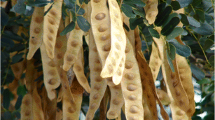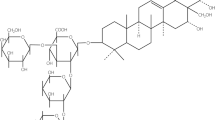Abstract
In the current study, in vitro evaluation of crude hexane, chloroform, ethyl acetate, acetone, and methanol extracts of Anisomeles malabarica (L.) R. Br., Gloriosa superba L., Psidium guajava L., Ricinus communis L., and Solanum trilobatum L. exhibited acaricidal and insecticidal activities against the adult of Haemaphysalis bispinosa Neumann (Acarina: Ixodidae) and hematophagous fly Hippobosca maculata Leach (Diptera: Hippoboscidae). All plant extracts showed moderate toxic effect on parasites after 24 h of exposure; the complete inhibition (100%) at the maximum concentration tested (3,000 ppm) was obtained in acetone, methanol, hexane, and chloroform extracts of A. malabarica; methanol, chloroform, and ethyl acetate extracts of G. superba; acetone extract of P. guajava; methanol extract of R. communis; and leaf hexane extract of S. trilobatum; and the lowest inhibition (38%) was recorded for the seed hexane extract of S. trilobatum. The highest parasite dead was found in leaf acetone and methanol extracts of A. malabarica, seed methanol of G. superba, leaf methanol of R. communis against H. bispinosa (LC50 = 466.15, 719.78, 476.06, and 243.87 ppm; LC90 = 1,837.96, 2,014.47, 1,904.36, and 2,692.15 ppm), leaf hexane and chloroform extracts of A. malabarica, seed chloroform and ethyl acetate of G. superba, leaf acetone of P. guajava, leaf methanol of R. communis, and leaf hexane extract of S. trilobatum against H. maculata (LC50 = 495.61, 414.81, 360.02, 479.37, 646.30, 506.13, and 432.77 ppm; LC90 = 1,914.84, 1,956.59, 1,598.54, 1,636.41, 2,192.73, 1,982.66, and 1,872.33 ppm), respectively. These results suggest that the leaf methanol of R. communis, chloroform extracts of A. malabarica, and chloroform extract of G. superba have the potential to be used as an ideal eco-friendly approach for the control of the H. bispinosa and H. maculata. Therefore, this study provides first report on the parasitic activities of plant extracts from Southern India.

Similar content being viewed by others
References
Ahmadi M, Moharramipour S, Mozdarani H, Negahban M (2008) Combined effect of gamma radiation and Perovskia atriplicifolia for the control of red flour beetle, Tribolium castaneum. Commun Agric Appl Biol Sci 73(3):643–650
Amer A, Mehlhorn H (2006) Larvicidal effects of various essential oils against Aedes, Anopheles, and Culex larvae (Diptera, Culicidae). Parasitol Res 99:473–477
Bagavan A, Kamaraj C, Elango G, Zahir AA, Rahuman AA (2009) Adulticidal and larvicidal efficacy of some medicinal plant extracts against tick, fluke and mosquitoes. Vet Parasitol 166:286–292
Bansal SK, Singh KV, Sherwani MR (2009) Evaluation of larvicidal efficacy of Solanum xanthocarpum storage against vector mosquitoes in north-western Rajasthan. J Environ Biol 30(5 Suppl):883–888
Broglio-Micheletti SM, Valente EC, Souza LA, Dias ND, Araújo AM (2009) Plant extracts in control of Rhipicephalus (Boophilus) microplus (Canestrini, 1887) (Acari: Ixodidae) in laboratory. Rev Bras Parasitol Vet 18(4):44–48
Cheng SS, Huang CG, Chen YJ, Yu JJ, Chen WJ, Chang ST (2009) Chemical compositions and larvicidal activities of leaf essential oils from two eucalyptus species. Bioresour Technol 100(1):452–456
Choochote W, Rongsriyam K, Pitasawat B, Jitpakdi A, Rattanachanpichai E, Junkum A, Tuetun B, Chaiwong P (2004) Evaluation of the colchicine-like activity of Gloriosa superba-extracted fractions for mosquito (Diptera: Culicidae) cytogenetic study. J Med Ent 41:672–676
Chowdhury N, Laskar S, Chandra G (2008) Mosquito larvicidal and antimicrobial activity of protein of Solanum villosum leaves. BMC Complement Altern Med 8:62–67
De Castro JJ (1997) Sustainable tick and tick borne disease control in livestock improvement in developing countries. Vet Parasitol 71:77–97
Deb DB (1979) Solanaceae in India. In: Hawkes JG, Lester RN, Skelding AD (eds) The biology and taxonomy of the solanaceae. Academic, London, pp 87–112
Devendra C (1995) Animal production systems in South East and East Asia: potential challenges for research. In: Proc Global agenda for livestock research, ILRI, January 18–20, pp 41–48
Erler F, Polat E, Demir H, Cetin H, Erdemir T (2009) Control of the mushroom phorid fly, Megaselia halterata (Wood), with plant extracts. Pest Manag Sci 65(2):144–149
FAO (2004) Ticks: acaricide resistance: diagnosis management and prevention in: guidelines resistance management and integrated parasite control in ruminants. FAO Animal Production and Health Division, Rome
Fernandes FF (2001) Toxicological effects and resistance to pyretroids in Boophilus microplus from Goia´s Brasil. Arq Bras Med Vet Zootec 53:548–552
Fernandes FF, Freitas EPS (2007) Acaricidal activity of an oleoresinous extract from Copaifera reticulata (Leguminosae: Caesalpinioideae) against larvae of the southern cattle tick, Rhipicephalus (Boophilus) microplus (Acari: Ixodidae). Vet Parasitol 147(1–2):150–154
Fernandes FF, Freitas EPS, Costa AC, Silva IG (2005) Larvicidal potential of Sapindus saponaria to control the cattle tick Boophilus microplus. Pesq Agropec Bras 40:1243–1245
Finnie JF, Van Staden J (1994) Gloriosa superba L. (Flame Lily): micropropagation and in vitro production of colchicines. In: Bajaj YPS (eds), Biotechnology in agriculture and forestry, vol. 26: Medicinal and Aromatic Plants VI, pp 146–166 (Chapter X)
Ghosh S, Bansal GC, Gupta SC, Ray D, Khan MQ, Irshad H, Shahiduzzaman M, Seitzer U, Ahmed JS (2007) Status of tick distribution in Bangladesh, India and Pakistan. Parasitol Res 101(2):S207–S216
Goven B, Gilbert J, Gratzek J (1980) Apparent drug resistance to the organophosphate dimethyl (2, 2, 2-trichloro-1-hydroxyethyl) phosphonate by monogenetic trematodes. J Wildl Dis 16(3):343–346
Govindan S, Viswanathan S, Vijayasekaran V, Alagappan R (2004) Further studies on the clinical efficacy of Solanum xanthocarpum and Solanum trilobatum in bronchial asthma. Phytothera Res 18:805–809
Goze I, Alim A, Dag S, Tepe B, Polat ZA (2009) In vitro amoebicidal activity of Salvia staminea and Salvia caespitosa on Acanthamoeba castellanii and their cytotoxic potentials on corneal cells. J Ocul Pharmacol Ther 25(4):293–298
Ivan A (1998) Chemical constituents, traditional and modern uses. In: Ross I (ed) Medicinal plants of the world. Ross Humana, Totowa, pp 375–395
Jacobson RL, Schlein Y (1999) Lectins and toxins in the plant diet of Phlebotomus papatasi (Diptera: Psychodidae) can kill Leishmania major promastigotes in the sandfly and in culture. Ann Trop Med Parasitol 93(4):351–356
Kamaraj C, Rahuman AA, Bagavan A (2008) Antifeedant and larvicidal effects of plant extracts against Spodoptera litura (F.), Aedes aegypti L. and Culex quinquefasciatus Say. Parasitol Res 103(2):325–331
Kamaraj C, Rahuman AA, Bagavan A, Elango G, Rajakumar G, Zahir AA, Marimuthu S, Santhoshkumar T, Jayaseelan C (2010) Evaluation of medicinal plant extracts against blood-sucking parasites. Parasitol Res 106:1403–1412
Khan H, Khan MA, Mahmood T, Choudhary MI (2008) Antimicrobial activities of Gloriosa superba Linn (Colchicaceae) extracts. J Enzyme Inhib Med Chem 23(6):855–859
Kweka EJ, Mosha F, Lowassa A, Mahande A, Kitau J, Matowo J, Massenga C, Tenu F, Feston E, Lyatuu E, Mboya M, Mndeme R, Chuwa G, Temu EA (2008a) Ethnobotanical study of some of mosquito repellent plants in north-eastern Tanzania. Malar J 7:152
Kweka EJ, Mosha FW, Lowassa A, Mahande AM, Mahande MJ, Massenga CP, Tenu F, Lyatuu EE, Mboya MA, Temu EA (2008b) Longitudinal evaluation of Ocimum and other plants effects on the feeding behavioral response of mosquitoes (Diptera: Culicidae) in the field in Tanzania. Parasites Vectors 1:42
Lima MG, Maia IC, Sousa BD, Morais SM, Freitas SM (2006) Effect of stalk and leaf extracts from Euphorbiaceae species on Aedes aegypti (Diptera, Culicidae) larvae. Rev Inst Med Trop São Paulo 48(4):211–214
Madhavan S, Balu S (1999) Ethnobotanical studies on Solanum trilobatum Linn.: an Indian drug plant. J Econ Taxon Bot 23(1999):43–46
Marshall CJ (1999) Use of Supaverm® for the treatment of monogenean infestation in koi carp (Cyprinus carpio). Fish Vet J 4:33–37
Minjauw B, Mc Leod A (2003) Tick-borne diseases and poverty. The impact of ticks and tick-borne diseases on the livelihood of small scale and marginal livestock owners in India and eastern and southern Africa. DFID Animal Health Programme, Centre for Tropical Veterinary Medicine, University of Edinburgh, Edinburgh
Mohan PV, Devi KS (1997) Effect of Sobatum on tumour development and chemically induced carcinogenesis. Cancer Lett 112:219–223
Mohan PV, Rao JM, Kutty MAS, Devi KS (1998) Cytotoxicity of extracts of Solanum trilobatum and anticarcinogenic activity of Sobatum. Biomedicine 18:106–111
Mohan L, Sharma P, Srivastava CN (2005) Evaluation of Solanum xanthocarpum extracts as mosquito larvicides. J Environ Biol 26(2):399–401
Nisha M, Kalyanasundaram M, Paily KP, Abidha VP, Balaraman K (2007) In vitro screening of medicinal plant extracts for macrofilaricidal activity. Parasitol Res 100(3):575–579
Nundkumar N, Ojewole JA (2002) Studies on the antiplasmodial properties of some South African medicinal plants used as antimalarial remedies in Zulu folk medicine. Meth Find Exp Clin Pharmacol 24(7):397–401
Periyanayagam K, Nirmala Devi K, Suseela L, Uma A, Ismail M (2008) In vivo antimalarial activity of leaves of Plectranthus amboinicus (lour) spreng on Plasmodium berghei yoelii. J Commun Dis 40(2):121–125
Puyvelde LV, Geysen D, Ayobangira FX, Hakizamungu E, Nshimiyimana A, Kalisa A (1985) Screening of medicinal plants of Rwanda for acaricidal activity. J Ethnopharmacol 13(2):209–215
Rahuman AA, Gopalakrishnan G, Venkatesan P, Geetha K (2008) Larvicidal activity of some Euphorbiaceae plant extracts against Aedes aegypti and Culex quinquefasciatus (Diptera: Culicidae). Parasitol Res 102(5):867–873
Rajkumar S, Jebanesan A (2004) Ovicidal activity of Solanum trilobatum Linn (Solanaceae) leaf extract against Culex quinquefasciatus Say and Culex tritaeniorhynchus Gile (Diptera: Culicidae). Int J Trop Insect Sci 24(4):340–342
Reddy PJ, Krishna D, Murthy US, Jamil K (1992) A microcomputer FORTRAN program for rapid determination of lethal concentration of biocides in mosquito control. CABIOS 8:209–213
Regassa A (2000) The use of herbal preparations for tick control in western Ethiopia. J S Afr Vet Assoc 71(4):240–243
Schmahl G, Mehlhorn H (1985) Treatment of fish parasites. 1. Praziquantel effective against Monogenea (Dactylogyrus vastator, Dactylogyrus extensus, Diplozoon paradoxum). Z Parasitenk 71:727–737
Schmahl G, Mehlhorn H, Haberkorn A (1988) Sym. triazinone (toltrazuril) effective against fish-parasitizing Monogenea. Parasitol Res 75(1):67–68
Sharma P, Mohan L, Srivastava CN (2004) Larval susceptibility of Ajuga remota against anopheline and culicine mosquitos. Southeast Asian J Trop Med Public Health 35(3):608–610
Sing NC, Johnston LAY, Leatch G (1983) The economics of cattle tick control in the dry tropical Australia. Aust Vet J 60:37–39
Singh RK, Dhiman RC, Mittal PK (2007) Studies on mosquito larvicidal properties of Eucalyptus citriodora Hook (family—Myrtaceae). J Commun Dis 39(4):233–236
Tadesse D, Eguale T, Giday M, Mussa A (2009) Ovicidal and larvicidal activity of crude extracts of Maesa lanceolata and Plectranthus punctatus against Haemonchus contortus. J Ethnopharmacol 122(2):240–244
Treves-Brown KM (1999) Availability of medicines for fish. Fish Vet J 4:40–55
Upasani SM, Kotkar HM, Mendki PS, Maheshwari VL (2003) Partial characterization and insecticidal properties of Ricinus communis L. foliage flavonoids. Pest Manag Sci 59:1349–1354
van den Broek AH, Huntley JF, Halliwell RE, Machell J, Taylor M, Miller HR (2003) Cutaneous hypersensitivity reactions to Psoroptes ovis and Der p 1 in sheep previously infested with P. ovis—the sheep scab mite. Vet Immunol Immunopathol 91:105–117
Wall R (2007) Ectoparasites: future challenges in a changing world. Vet Parasitol 1481:62–74
Yadav R, Srivastava VK, Chandra R, Singh A (2002) Larvicidal activity of latex and stem bark of Euphorbia tirucalli plant on the mosquito Culex quinquefasciatus. J Commun Dis 34(4):264–269
Zahir AA, Rahuman AA, Kamaraj C, Bagavan A, Elango G, Sangaran A, Kumar BS (2009) Laboratory determination of efficacy of indigenous plant extracts for parasites control. Parasitol Res 105:453–461
Acknowledgments
The authors are grateful to C. Abdul Hakeem College Management, Dr. S. Mohammed Yousuff, Principal, and Dr. K. Abdul Subhan, HOD of Zoology Department for their help and suggestion. The authors wish to thank Dr. A. Sangaran, Department of Parasitology, Madras Veterinary College, Tamil Nadu Veterinary and Animal Sciences University, Chennai, India for identification of parasites.
Author information
Authors and Affiliations
Corresponding author
Rights and permissions
About this article
Cite this article
Zahir, A.A., Rahuman, A.A., Bagavan, A. et al. Evaluation of botanical extracts against Haemaphysalis bispinosa Neumann and Hippobosca maculata Leach. Parasitol Res 107, 585–592 (2010). https://doi.org/10.1007/s00436-010-1898-7
Received:
Accepted:
Published:
Issue Date:
DOI: https://doi.org/10.1007/s00436-010-1898-7




